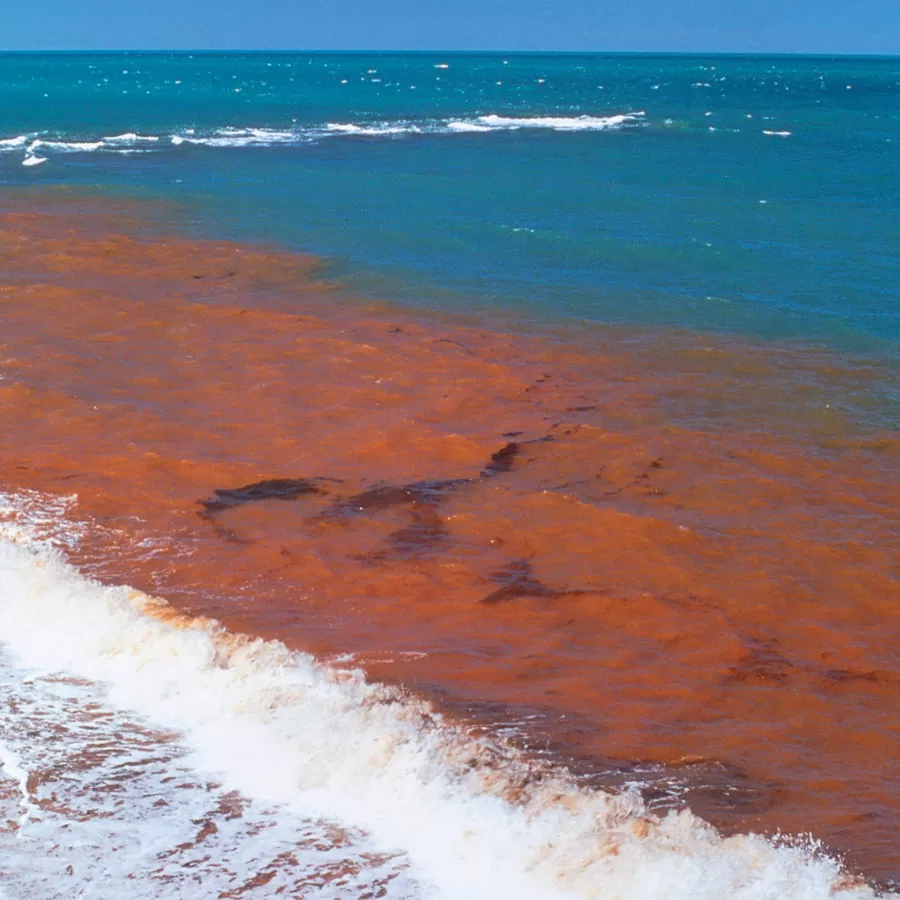Instructions:
- Become an expert in Algal blooms
- Read and study the documents that have been given to your group (just below)
- You have to be able to explain it to your classmates of other groups !
Harmful Algal Blooms
Harmful algal blooms are a major environmental problem in all 50 states. Known as red tides, blue-green algae or cyanobacteria, harmful algal blooms have severe impacts on human health, aquatic ecosystems and the economy.
Website : https://www.epa.gov/nutrientpollution/harmful-algal-blooms
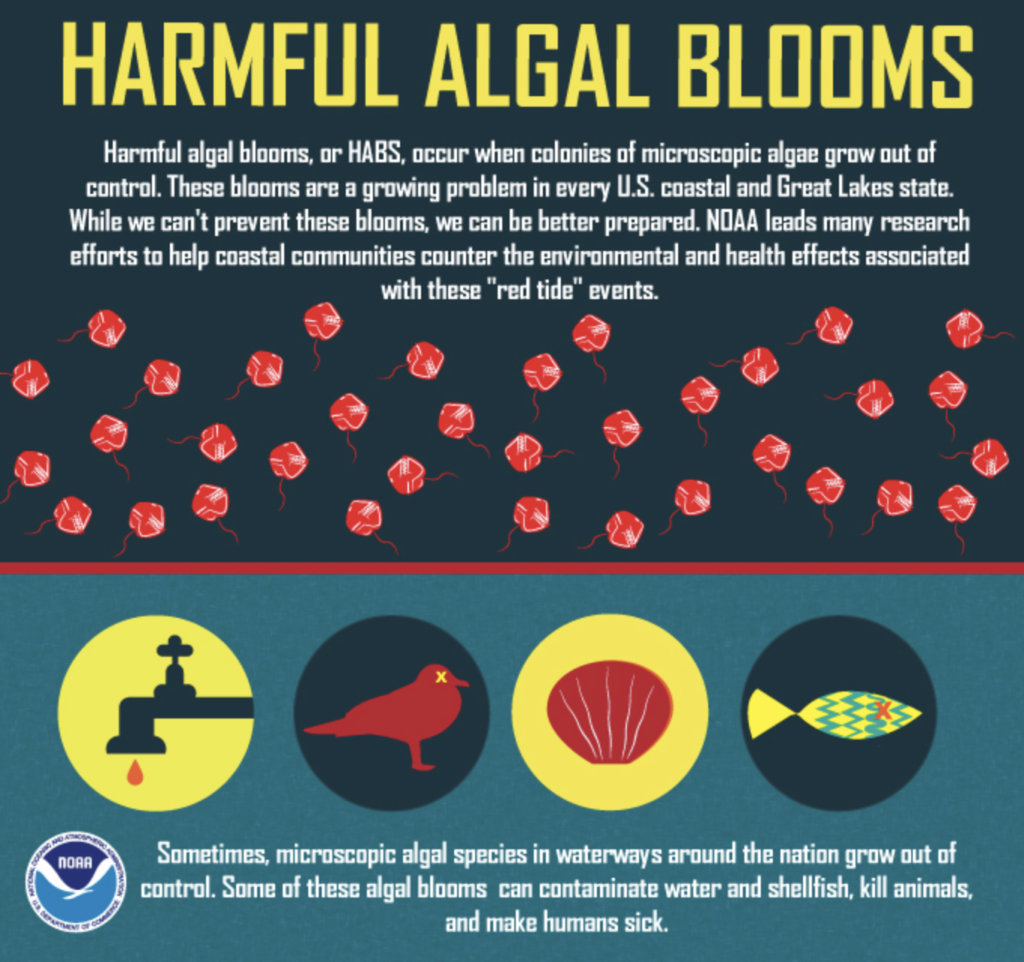
What is an Algal bloom?

An algal bloom or marine bloom or water bloom is a rapid increase in the population of algae in an aquatic system.
Algal blooms may occur in freshwater as well as marine environments.
Typically only one or a few phytoplankton species are involved and some blooms may be recognized by discoloration of the water resulting from the high density of pigmented cells.
Although there is no officially recognized threshold level, algae can be considered to be blooming at concentrations of hundreds to thousands of cells per milliliter, depending on the causative species.
Algal bloom concentrations may reach millions of cells per milliliter.
Colors observed are green, yellowish-brown, or red.
Bright green blooms may also occur.
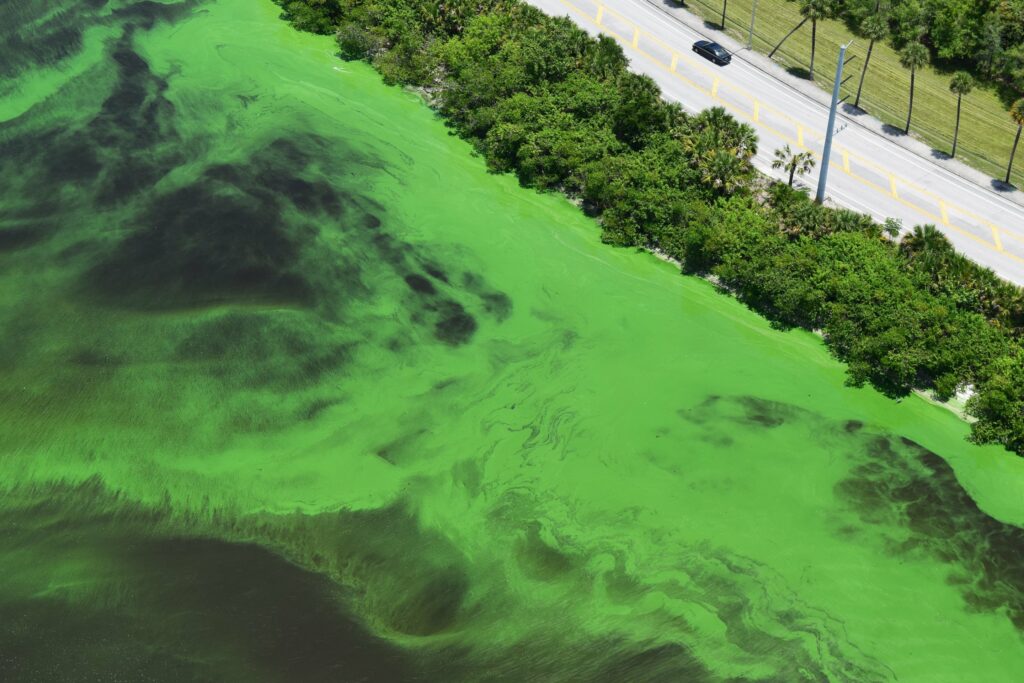
These are a result of blue-green algae, which are actually bacteria (cyanobacteria).
Some algal blooms are the result of an excess of nutrients (particularly phosphorus and nitrogen) into waters and higher concentrations of these nutrients in water cause increased growth of algae and green plants.
As more algae and plants grow, others die.
This dead organic matter becomes food for bacteria that decompose it.
With more food available, the bacteria increase in number and use up the dissolved oxygen in the water.
When the dissolved oxygen content decreases, many fish and aquatic insects cannot survive.
This results in a dead area.
Algal blooms may also be of concern as some species of algae produce neurotoxins.
At the high cell concentrations reached during some blooms, these toxins may have severe biological impacts on wildlife.
Algal blooms composed of phytoplankters known to naturally produce biotoxins are often called Harmful Algal Blooms, or HABs.
https://www.sciencedaily.com/terms/algal_bloom.htm
Sometimes Tiny Algae Can Cause Big Problems
Harmful algal blooms occur nearly every summer along the nation’s coasts. Often, the blooms turn the water a deep red. While many people call all such events « red tides, » scientists prefer the term harmful algal bloom.
What is Red Tide?
A red tide, or harmful algal bloom, is the rapid growth of microscopic algae. Some produce toxins that have harmful effects on people, fish, marine mammals, and birds. In Florida and Texas, this is primarily caused by the harmful algae species, Karenia brevis. It can result in varying levels of eye and respiratory irritation for people, which may be more severe for those with pre-existing respiratory conditions (such as asthma). The blooms can also cause large fish kills and discolored water along the coast.
How Does the NOAA Forecast Work?
Use the website of NOAA to have all the news you need: https://oceanservice.noaa.gov/news/redtide-florida/welcome.html
What Causes Red Tide?
Major factors influencing red tide events include warm ocean surface temperatures, low salinity, high nutrient content, calm seas, and rain followed by sunny days during the summer months (NOAA). In addition, algae related to red tide can spread or be carried long distances by winds, currents, storms, or ships.
Where Are Red Tides Found?
Red tide is a global phenomenon. However, since the 1980s harmful red tide events have become more frequent and widespread. Detection of a spread is thought to be influenced by higher awareness of red tide, better equipment for detecting and analyzing red tide, and nutrient loading from farming and industrial runoff. Countries affected by red tide events include: Argentina, Australia, Brazil, Canada, Chile, Denmark, England, France, Guatemala, Hong Kong, India, Ireland, Italy, Japan, the Netherlands, New Zealand, Norway, New Guinea, Peru, the Philippines, Romania, Russia, Scotland, Spain, Sweden, Thailand, the United States, and Venezuela (WHOI, 2007, CDC, 2012).
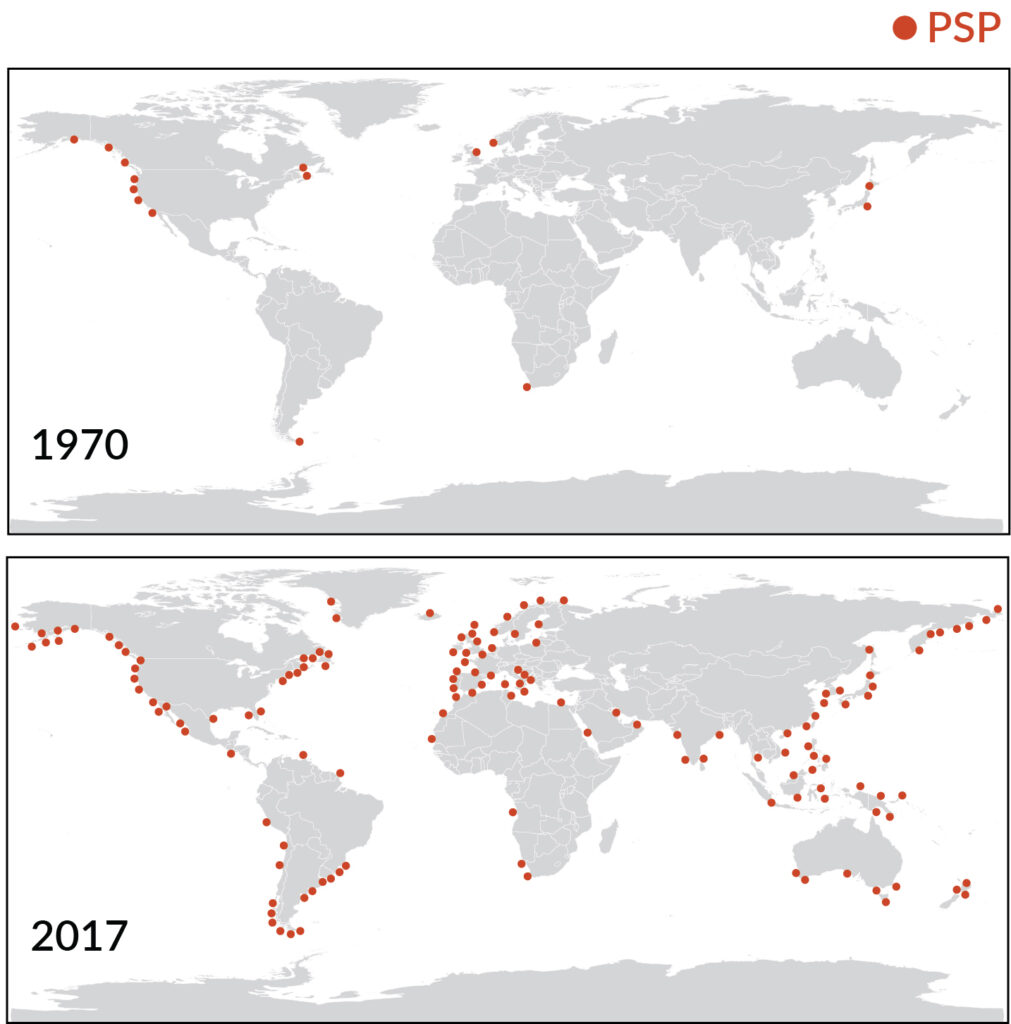
How Are Red Tides Harmful?
Red tide algae make potent natural toxins. It is unknown why these toxins are created, but some can be hazardous to larger organisms throught the processes of biomagnification and bioaccumulation. Grazers such as fish and krill are unaffected by the toxins, so as they eat the algae the toxins are concentrated and accumulate to a level that is poisonous eat to organisms that feed on them. Large fish kills and several mammalian diseases and deaths have been attributed to consumption of shellfish during red tide algal blooms. Diseases that may affect humans include:
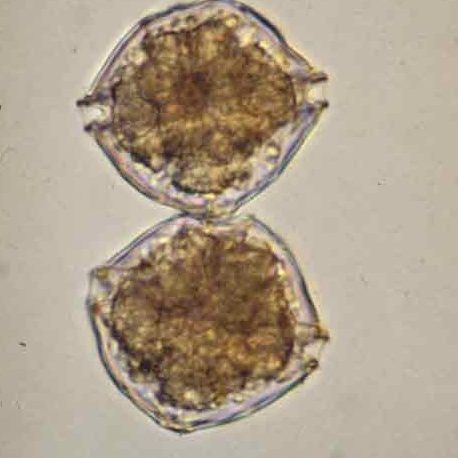
• Paralytic Shellfish Poisoning (PSP) – This disease is caused by the production of saxitoxin by the Alexandrium species. It is common along the Atlantic and Pacific coasts in the US and Canada. Poisoning occurs when one ingests shellfish contaminated with PSP toxins causing disruption of nerve function and paralysis. Extreme cases may result in death by asphyxiation by respiratory paralysis. (photo from: https://hab.whoi.edu/species/species-by-name/alexandrium/)

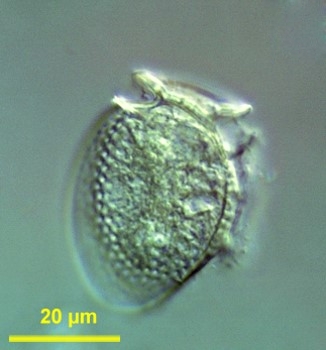
• Diarrhetic Shellfish Poisoning (DSP) – This disease is caused by the Dinophysis species. It generally occurs in Japan and Europe, but it has also been found in other countries such as Canada, the US, Chile, New Zealand, and Thailand. Symptoms of DSP include diarrhea, nausea, vomiting, abdominal pain, and cramps. DSP is generally not lethal. (photo from: wikipedia)
• Amnesic Shellfish Poisoning (ASP) – This disease, which has been found along the eastern Canadian coast, is caused by domoic acid producing planktonic and benthic algae, including Pseudo-nitzschia pungens forma. Pseudo-nitzschia multiseries and Amphora coffaeformis. It can also be found in soft shell clams and blue mussels infected by Pseudo-nitzschia delicatissima. Gastric and neurological symptoms include dizziness, disorientation and memory loss.
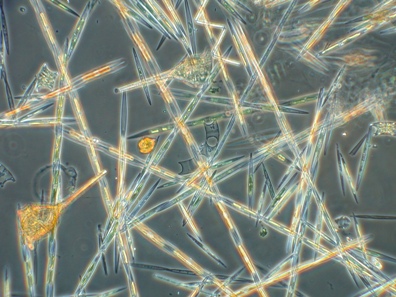
What is Being Done About Red Tide?
Technological advancements such as satellite imagery have allowed scientists to better track and monitor harmful algal blooms.
news from: http://serc.carleton.edu/microbelife/topics/redtide/index.html
Impacts of red tide toxins on seabirds
JULY 28, 2014 BY DEBORAH FAUQUIER, DVM, PHD, MPVM
Estuaries are highly productive and ecologically rich areas that are important habitats for fish and bird species.
Over the past few decades, the frequency and duration of harmful algal blooms (HABs) have been increasing globally in coastal areas. HABs, especially those caused by the red tide organism, Karenia brevis, occur frequently along Florida’s west coast, causing episodes of high mortality in fish, sea turtles, birds, bottlenose dolphins and manatees.
Although red tide is known to cause episodes of large scale mortality among marine animals, it is not known whether this disturbance results in significant declines in animal populations or changes in community structure.
This project determined the extent that the red tide toxin, brevetoxin, contributed to illness and death in stranded fish-eating birds from the Sarasota Bay area. In addition, how red tide influenced the abundance, habitat use, and behavior of fish-eating birds in the Sarasota Bay estuary was investigated.
Red tide bloom events caused by the dinoflagellate K. brevis occurred along the central west Florida coast from February 2005 through December 2005, and August 2006 through December 2006. During these events, from 4 February 2005 through 28 November 2006, sick sea birds admitted for rehabilitation showed clinical signs including disorientation, inability to stand, incoordination, and seizures. Testing for brevetoxin by enzyme-linked immunosorbent assay found toxin present in 69% (n=95) of rehabilitating sea birds. Twelve of the 19 species of birds tested positive for brevetoxin exposure. Double-crested cormorants were the most commonly affected species and presented with more severe neurological signs as compared to other species. Serial blood and fecal samples taken from several live sea birds during rehabilitation showed that brevetoxin was cleared within 5-10 days from the animals’ bodies.
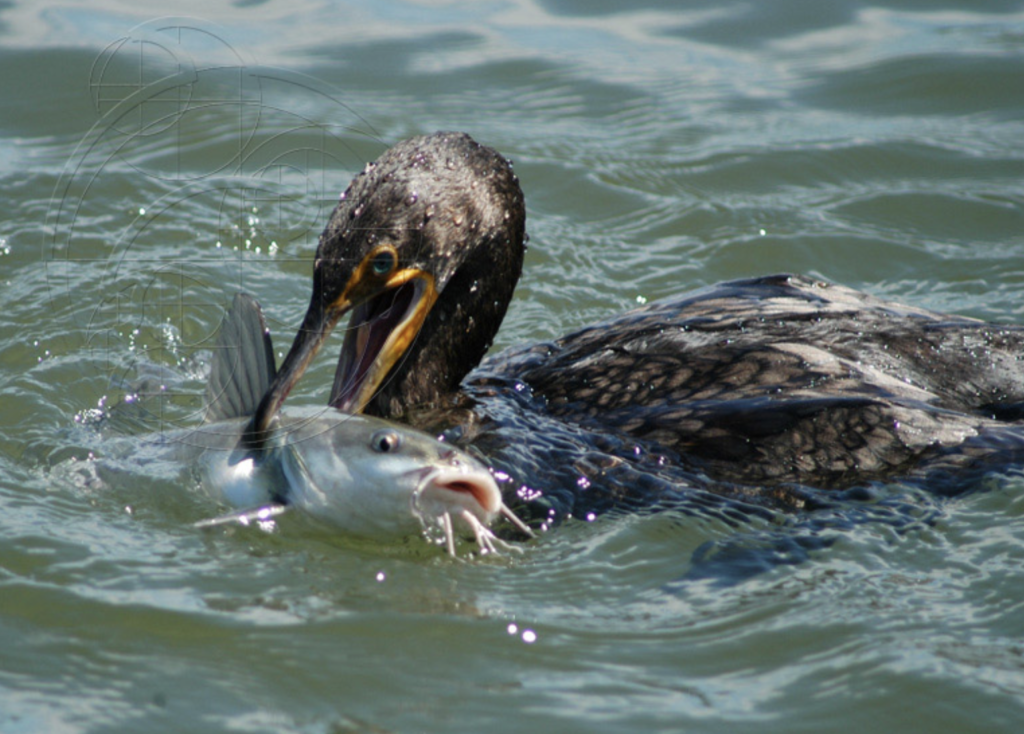
More than 35,000 bird observations from boat-based surveys were obtained during summer and winter seasons from 2006 through 2009 in Sarasota Bay, involving more than 30 different species. The most abundant bird species were double-crested cormorants, laughing gulls, and brown pelicans. Periods of high red tide cell densities (>10,000 cells per liter) occurred during the summer 2006 and the winter 2007 seasons. Overall bird abundance was lower during red tide blooms than at other times. In particular, the lower density of birds was attributed to decreased abundance of double-crested cormorants in all habitats during red tide bloom conditions. In contrast, brown pelicans and laughing gulls had no change or increased in abundance during red tide conditions. It is probable that cormorants are consuming different prey than pelicans and gulls and may be exposed to a higher dose of toxin leading to increased illness and death, and lower abundances during red tide events. This project was supported by a Morris Animal Foundation Research Grant, Florida’s State Wildlife Grants Program, and an EPA Star Fellowship.
Florida Fish and Wildlife
Conservation Commission
Karenia brevis, the Florida red tide organism, produces brevetoxins, toxins harmful to fish, marine mammals and birds. Insert default « GallerySection » markup here
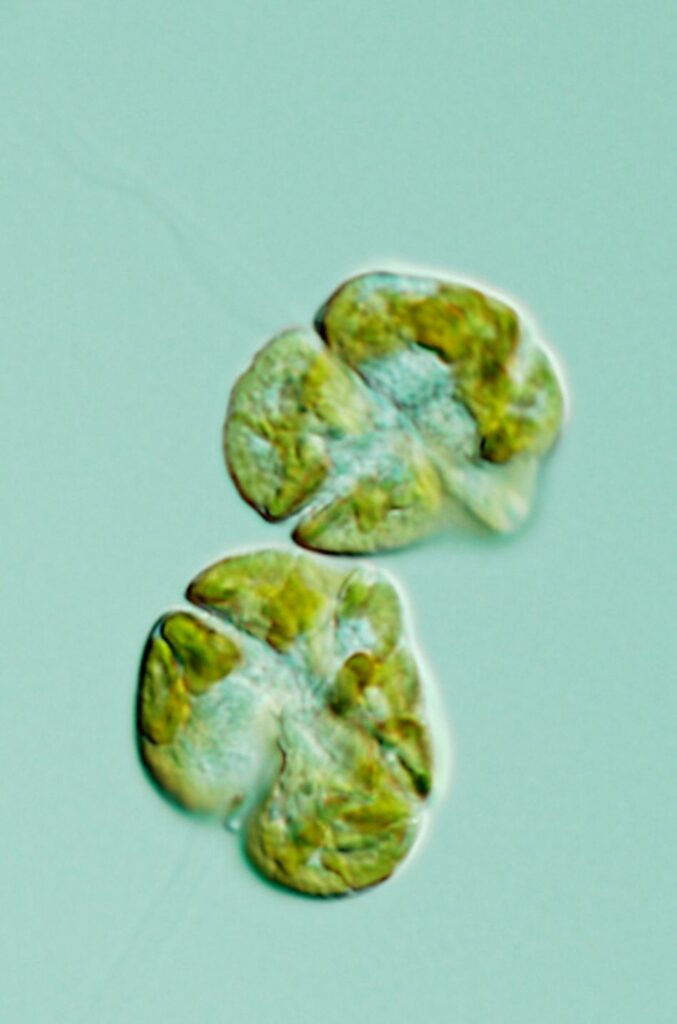
Karenia brevis produces toxins called brevetoxins that affect a variety of marine wildlife. Aquatic organisms can be exposed to brevetoxins in several ways: coming into contact with K. brevis cells or toxins in the water, ingesting cells, inhaling toxins and consuming toxic prey. Brevetoxins can accumulate in primary consumers such as zooplankton, fish, bivalves and other filter feeders. From these organisms, the toxins can be transferred to predators such as fish, crustaceans and other bottom-dwelling organisms. The accumulation and persistence of brevetoxins in these marine animals and environments such as seagrass and sediment can eventually lead to the transfer of these toxins to larger animals, including sea turtles, birds and marine mammals. Here’s a more detailed look at how K. brevis toxins affect different animals.
FISH
Large numbers of fish are affected by Florida red tide.
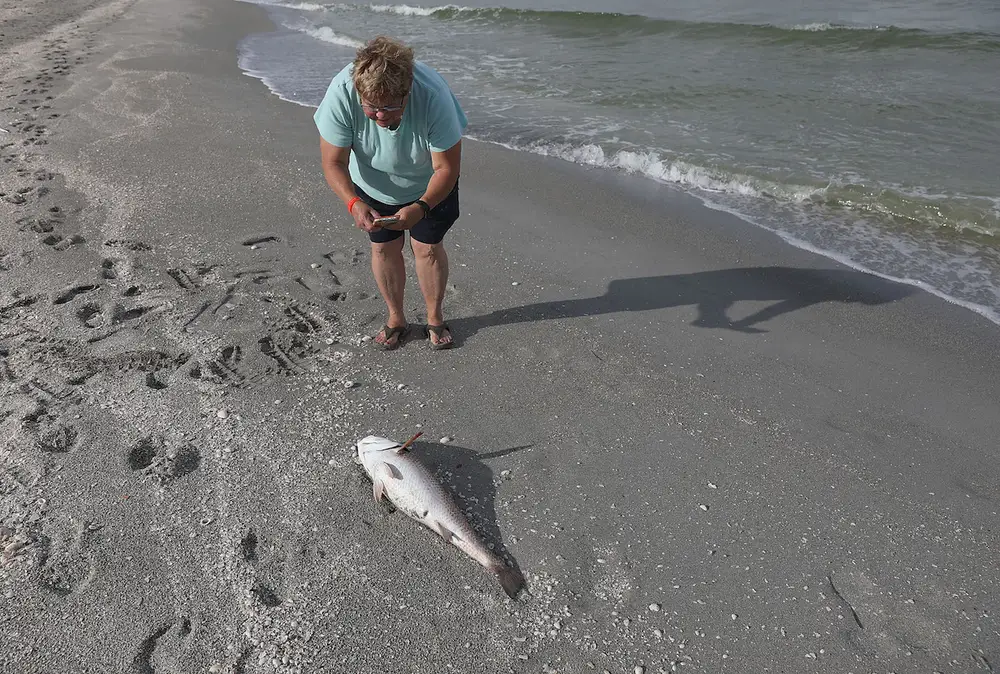
Fish are most affected by Florida red tide, and fish kills are often the only noticeable effects of blooms. Large scale die-offs have been observed with red tides since 1844, but the organism responsible, K. brevis, was not identified until 1946. Brevetoxins affect fish regardless of species or developmental stage. Signs of
intoxication in fish include violent twisting and corkscrew swimming, defecation and regurgitation, pectoral fin paralysis, caudal fin curvature, loss of equilibrium and convulsions. Ultimately, fish die because their gills stop functioning. In most instances, death from brevetoxin exposure is immediate; however, death can occur after long-term exposure to toxins. Fish typically die when exposed to 250,000 K. brevis cells per liter of water, although this threshold varies with bloom concentration and exposure. Shark species have also been affected during multi-species fish kills, but large scale die-offs of sharks are rare.
INVERTEBRATES
Bay scallop.
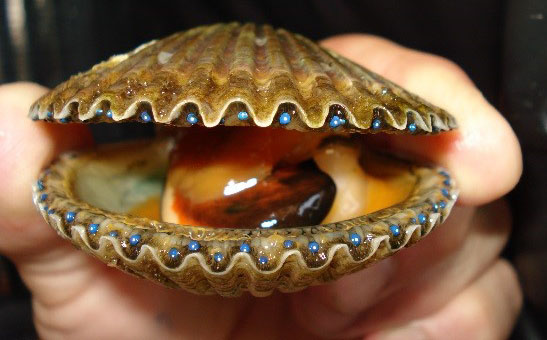
Red tides can also lead to die-offs of invertebrates, including shrimp, sponges, sea urchins, crabs and certain shellfish. In most cases, it is unclear whether invertebrate die-offs occur because of exposure to toxins or the low-oxygen conditions resulting from blooms. Although most bivalve shellfish appear to be unaffected during K. brevis blooms, bay scallop (Argopecten irradians) kills have been documented. Lab studies have shown that survival of bivalves depends on maturity; larvae are more susceptible than developed invertebrates.
SEA TURTLES
Dead loggerhead sea turtle.
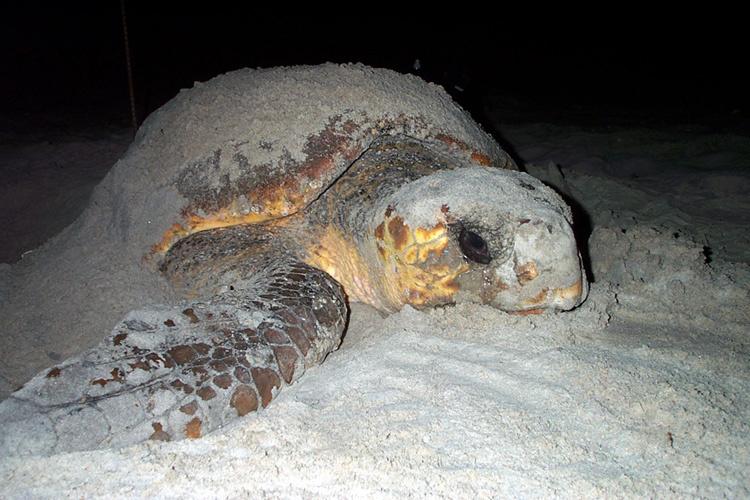
Strandings of live and dead sea turtles increase during K. brevis blooms. Signs that a sea turtle has been exposed to brevetoxins include swimming in circles, lack of coordination, head bobbing, muscle twitching, jerky body movements and extreme lethargy. It is possible to successfully rehab sea turtles; however, it can take up to 50 days for the toxins to clear their system. During prolonged blooms along Florida’s central-west coast in 2005 and 2006, more than 300 sea turtles stranded, representing a four-fold increase over the previous 12-year average. Brevetoxins caused or contributed to the strandings of 95 percent of turtles tested during this period. Loggerheads (Caretta caretta), Kemp’s ridley (Lepidochelys kempii) and green turtles (Chelonia midas) were the species affected. Loggerheads were most affected and took much longer to recover than the others.
BIRDS
Dead pelican.
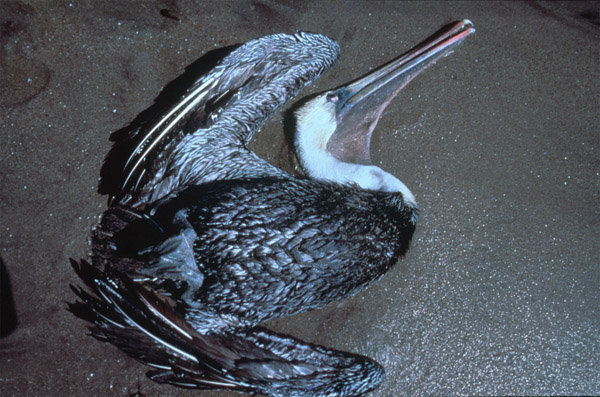
Mass die-offs of coastal seabirds and shorebirds are common during K. brevis blooms because
birds consume fish and crustaceans contaminated with toxins. Some of the commonly reported species affected include double-crested cormorants (Phalacrocorax auritus), lesser scaup (Aythya affinis) and brown pelicans (Pelecanus occidentalis). Sick birds exhibit an inability to stand, slumping of the head, weakness, reluctance to fly, seizures, nasal and oral discharge, labored breathing and dehydration.
MARINE MAMMALS
Bottlenose dolphin
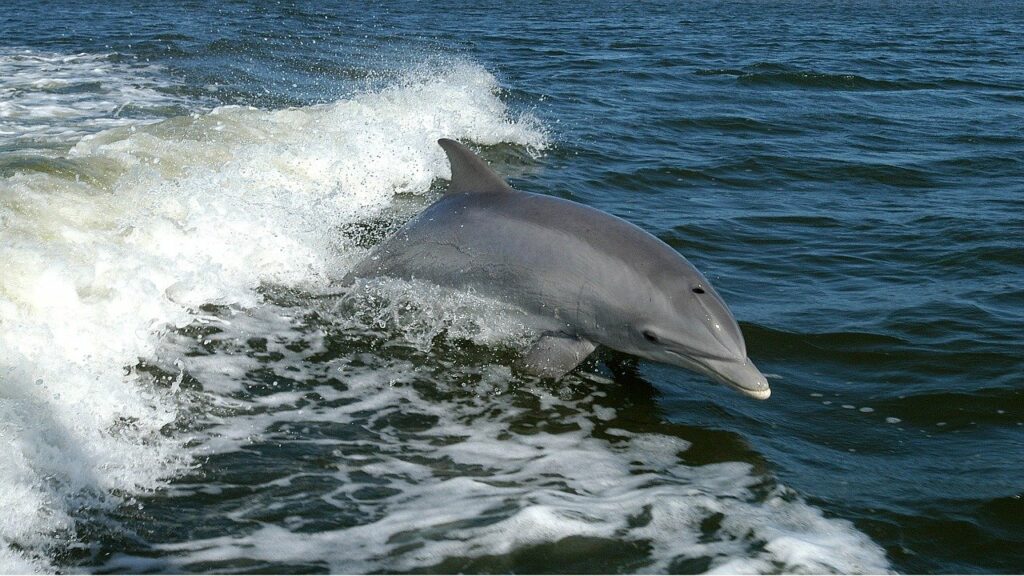
The first record of a marine mammal die-off caused by a Florida red tide occurred off the southwest coast of Florida during 1946 and 1947. Marine mammals are affected by consuming contaminated prey or by inhaling toxins. Karenia brevis blooms that span a large range and persist for long periods are most harmful to marine mammals. For example, when a red tide spanned across 150 miles of Florida’s shoreline between 1953 and 1955, catastrophic die-offs of marine animals were recorded.
Dolphins
The largest dolphin die-off caused by a red tide resulted in more than 740 bottlenose dolphin strandings, many of which were already dead, along the U.S. Atlantic coast from June 1987 to May 1988. Four other notable bottlenose dolphin die-offs have been recorded since that time, three of which occurred in the Florida Panhandle. Although this event did not coincide with an identifiable K. brevis bloom, brevetoxins were found in all of the dolphins tested. Baitfish, Menhaden (Brevoortia sp.), containing high concentrations of brevetoxins were the most common prey identifiable in dolphin stomach contents, revealing the source of the brevetoxins. In a third Panhandle event, almost 100 bottlenose dolphins died, with strandings initially coinciding with dense K. brevis blooms. Despite differences in bloom conditions, 93 percent of the dolphins tested were positive for brevetoxins.
Manatees
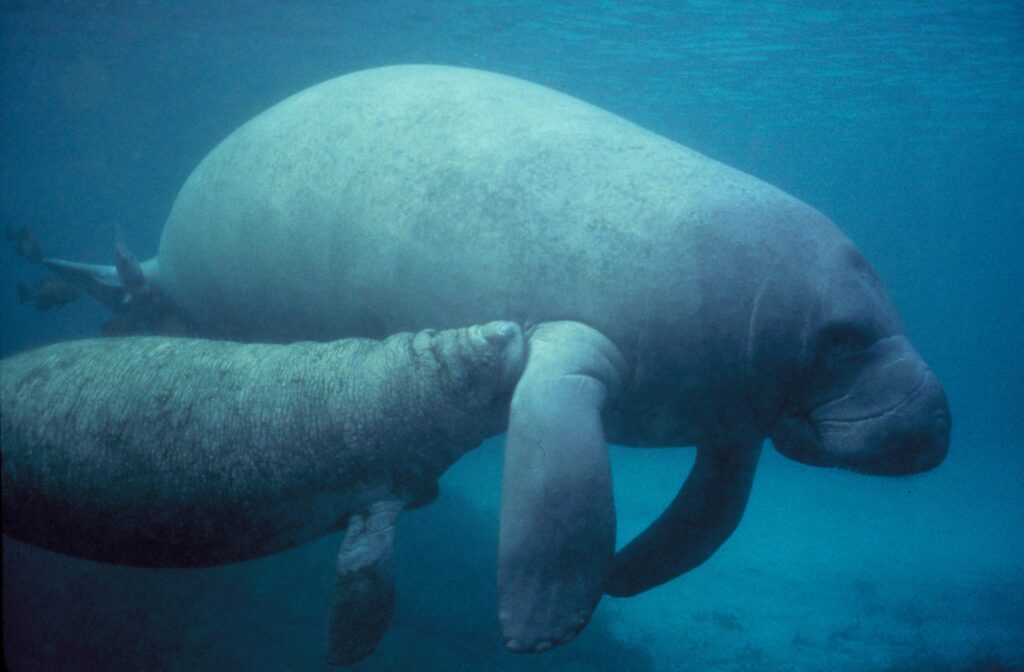
Suspected red tide-related deaths of the endangered Florida manatee (Trichechus manatus latirostris) were first reported in 1965, and several notable, extensive die-offs have occurred within the last three decades. In 1982, numerous sick manatees were observed during a K. brevis bloom, and deaths continued for three weeks after the bloom subsided. Researchers believe brevetoxins accumulated in filter-feeding organisms attached to seagrass blades, which were then eaten by manatees. A similar, but larger-scale event occurred during a bloom in 1996. In this case, there were fewer reports of sick manatees, but researchers recorded an unprecedented number of manatee deaths. Manatees were recovered in areas with high K. brevis cell concentrations, and the end of the die-off closely followed the dissipation of the bloom. The stomach contents of several animals were found to be toxic, again indicating ingestion as a primary route of brevetoxin exposure. Further manatee die-offs from exposure to red tide toxins were recorded in southwest Florida in 2002, 2003, 2005, 2007, and most recently in 2013.
http://myfwc.com/research/redtide/general/marine-animals/

